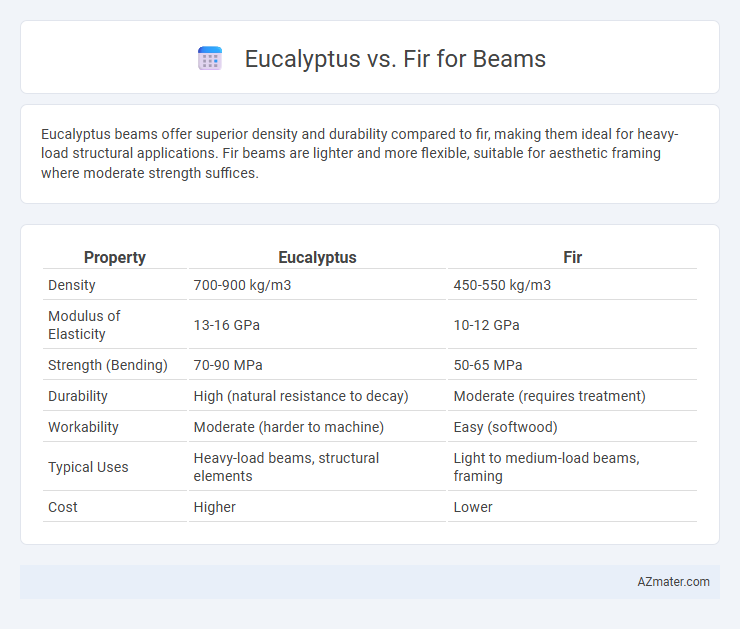Eucalyptus beams offer superior density and durability compared to fir, making them ideal for heavy-load structural applications. Fir beams are lighter and more flexible, suitable for aesthetic framing where moderate strength suffices.
Table of Comparison
| Property | Eucalyptus | Fir |
|---|---|---|
| Density | 700-900 kg/m3 | 450-550 kg/m3 |
| Modulus of Elasticity | 13-16 GPa | 10-12 GPa |
| Strength (Bending) | 70-90 MPa | 50-65 MPa |
| Durability | High (natural resistance to decay) | Moderate (requires treatment) |
| Workability | Moderate (harder to machine) | Easy (softwood) |
| Typical Uses | Heavy-load beams, structural elements | Light to medium-load beams, framing |
| Cost | Higher | Lower |
Introduction to Eucalyptus and Fir as Beam Materials
Eucalyptus and fir are prominent timber choices for beams due to their distinct structural properties and availability. Eucalyptus wood is prized for its high density and durability, offering strong resistance to wear and moisture, which makes it suitable for heavy load-bearing applications in construction. Fir, known for its straight grain and lighter weight, provides excellent dimensional stability and ease of handling, making it a preferred option for interior beams and residential framing.
Botanical and Structural Differences
Eucalyptus beams are derived from hardwood species like Eucalyptus globulus, known for their dense, durable wood with high tensile strength and natural resistance to decay, making them suitable for heavy load-bearing applications. Fir beams, typically from species such as Douglas Fir (Pseudotsuga menziesii), offer a lighter, moderately strong softwood with a straight grain and excellent dimensional stability, preferred in residential framing for its workability. Structurally, eucalyptus's higher modulus of elasticity and hardness provide superior resistance to bending and compression compared to fir, which balances strength with ease of handling and fast drying times.
Strength and Load-Bearing Capacity Comparison
Eucalyptus wood generally offers higher density and strength compared to fir, making it a robust choice for structural beams with superior load-bearing capacity. Fir, known for its straight grain and lighter weight, provides adequate strength but is less capable of handling heavy loads than eucalyptus. In construction requiring maximum durability and heavy-duty support, eucalyptus beams outperform fir by delivering enhanced resistance to bending and compression.
Durability and Resistance to Insects and Decay
Eucalyptus beams exhibit superior durability and natural resistance to insects and decay compared to fir, making them ideal for structural applications in humid or termite-prone environments. Fir beams, while lighter and easier to work with, require chemical treatments to enhance their insect and decay resistance, limiting their long-term performance in harsh conditions. The dense, oily properties of eucalyptus wood contribute to its enhanced longevity and structural integrity in beam construction.
Workability and Ease of Machining
Eucalyptus wood offers moderate workability with a dense grain that requires sharp tools for precise machining, making it suitable for beams needing durability and aesthetic appeal. Fir, known for its light weight and straight grain, provides superior ease of machining and smoother cutting, ideal for structural beams where quick processing is essential. Both woods vary in hardness; eucalyptus demands more effort but ensures strong, long-lasting beams, while fir allows efficient shaping with less wear on tools.
Cost and Availability in the Market
Eucalyptus beams generally offer a more cost-effective option compared to fir due to their faster growth rates and abundant supply in tropical regions, making them widely available in markets focused on sustainable timber. Fir beams, while more expensive, are prized for their strength and consistent quality, commonly sourced from temperate forests with more limited but steady availability. Market prices for eucalyptus fluctuate less due to its rapid renewal, whereas fir's cost can rise with increasing demand and longer growth cycles.
Environmental Impact and Sustainability
Eucalyptus beams offer rapid growth rates and high carbon sequestration, making them a renewable resource with lower environmental impact compared to traditional fir. Fir beams, sourced from slower-growing conifers, often require longer harvesting cycles, which can affect forest biodiversity and carbon storage negatively. Sustainable eucalyptus forestry practices, including selective harvesting and replanting, enhance soil conservation and reduce deforestation risks, while certified fir beams from responsibly managed forests support ecosystem health and biodiversity.
Aesthetic Appeal and Surface Finishing
Eucalyptus offers a warm, reddish-brown hue with a smooth, fine grain that enhances aesthetic appeal and allows for a polished surface finishing ideal for modern interiors. Fir beams showcase a light cream to yellow color with a straight, uniform grain that provides a clean, rustic look and accepts stains and finishes evenly for a versatile appearance. Both woods respond well to sanding and sealing, but fir tends to highlight its natural texture more prominently, while eucalyptus delivers a richer, more luxurious surface finish.
Common Applications in Construction
Eucalyptus beams are favored in construction for their high strength-to-weight ratio, durability, and resistance to pests, making them suitable for heavy load-bearing structures, flooring, and outdoor frameworks. Fir beams offer consistent grain patterns and flexibility, commonly used in residential framing, roof trusses, and interior finishing where moderate strength and ease of handling are required. Both woods support sustainable building practices but choosing between them depends on the specific load requirements, environmental exposure, and aesthetic preferences in construction projects.
Final Recommendations: Choosing Between Eucalyptus and Fir
Eucalyptus wood offers superior durability and resistance to moisture, making it ideal for beams in outdoor or high-humidity environments, while fir provides lighter weight and excellent workability suited for indoor structural applications. Fir beams typically have a more uniform grain and fewer knots, contributing to better aesthetic appeal and predictable strength, whereas eucalyptus often requires more treatment to enhance longevity. For long-term structural projects requiring robustness and weather resistance, eucalyptus is recommended; fir is preferred for cost-effective, easy-to-install beams in controlled indoor settings.

Infographic: Eucalyptus vs Fir for Beam
 azmater.com
azmater.com